Violin microphone on the cheap
or
Nobody in their right mind would ever use DIN for a mic
A dissertation on orchestral amplification
Background
Kårspexet is an amateur farce
group at KTH (The Royal Institute of
Technology) in Stockholm. As such, we have a 20 piece orchestra to
back up six actors with some semblence of music. This orchestra sounds
great unplugged in an orchestra pit. Problem is, not all theaters in
Stockholm have a pit that can accomodate an orchestra that large,
drums and all. This is usually solved by placing the orchestra somewhere
else and amplifying. At the theatre where the following was
attempted, Göta Lejon, the orchestra was placed on the
balcony.
Caveats
There are pros and cons to both acoustic and amplified. The
orchestra pit was a good idea before the advent of the Senneheiser
MKE-2 lavalier and wireless bodypacks. A lot of the orchestra can leak
into the actor's microphones, especially cymbals and hihats and other
percussion oddities. This is not a good thing. On the other hand, by
tolerating some leakage and some clever plexiglass placement, keeping
track of 8 channels is a lot easier than keeping track of 30. The
orchestra sounds more natural, and the singing sounds great if the
actors stay the hell away from the orchestra pit (also known as
"closest to the audience, farthest from the scenery" and where all the
dance numbers take place).
Micing the orchestra and placing it somewhere else/covering it up
results in cleaner input in the actor mikes. This doesn't stop the
problem with the drums and guitar amplifiers leaking in the orchestra
mics.Guitar amplifiers can be turned down, but having a drummer not
hit the cymbals and not bang the living daylights out of the toms is a
rare sight.
The leakage is worst on the strings and light winds, as they can't
produce the same quantity of moving air that a trombone can. You need
a good condenser or an ElectroVoice ND-308 in front of each, and
condensers are great at picking up just about everything. A lot of the
music alternates between quiet and loud. This is called being dynamic
and is unheard of in most rock'n'roll. Our music writers tend to write
stuff that is dynamic. Plus instruments move around a bit, so you get
varying levels when the orchestra won't cooperate (hint: they never
do. Especially when on tour in Finland).
The solution
The obvious solution is to jam an MKE-2 or a
DPA-3 into each violin (you can get away with a close-miced SM57 or
Schoeps condenser on most of the winds). Given a good bugdet, this is
what people do, but Kårspexet doesn't have that bugdet. Drat.
But wait! You can buy cheap electret microphone elements from your friendly electronics supplier, you
say. All you have to do is jam them down the F-hole of a violin and
you're set! Except for a few things:
How do you jam the thing down the F-hole and keep it there?
How do you power the electret element (they need a bias
voltage of 5-12V)?
How do you run the signal through over 100 meters of
multicore without picking up noise?
Send in the clowns
Some people in Linköping did the thinking for us, but we did a lot of
this our own way to suit ourselves. First things first, we need to
mount the thing. Easiest is to hook something to the side.
First, you take a piece of 1mm sheet metal (27x56), bend the top
15 mm to a 80 degree angle. Drill a 4mm hole towards the non-bent end,
and glue on a mouse pad cut to size (JBL speaker cone glue works
lovely). Add something elastic (zipcord, rubber band) in the hole you
drilled.
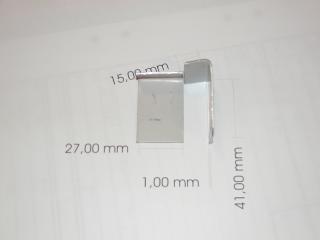
The sheetmetal thingy (yes, I CAD:ed it...)
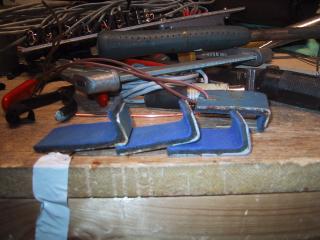
Now with mousepad.
Next, solder your microphone element onto a piece of flexibel
microphone cable, leaving about 5-10 mm of the individual conductors
free. Take about 10 cm 2,5 mm² copper wire (We used regular EKK house
wiring. A bicycle spoke was the original idea, but copper wire works
better IMHO) and shrink-tube it to the cable. Match up the ends of the
wire with the cable (if your element fits in the F-hole, you can skip
the 5-10 mm slack).
Now, bend the wire. See pictures. Glue or weld it to the metal
plate. Duct tape or gaffers tape also works.
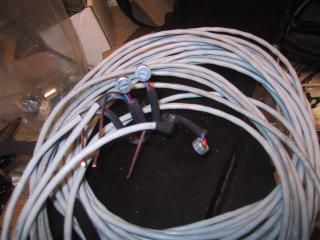
Microphones assembled. Gratuitious use of shrinktube
Hook the thing to the side of a violin and get the element down
the F-hole. Make sure that the element is held still, it cannot rattle
around in there. Rattling elements bother the violinists, and happy
violinists are good violinists. If you use a small enough element, it
can "float" inside the hole (this requires having mounted the copper
wire right against the element). Otherwise, adjust so that the element
is held taught against the wood from the underside. Hold the hooked
plate in place with elastic around the bottom button thingy. Adjust so
everything stays put.
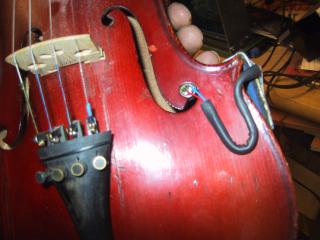
Everything monted. Note the signal wires left freely.
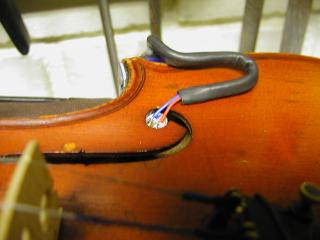
F-hole closeup. Note that the element is actually under the wood
So now what?
Here's where we started thinking. Our original inspiration hade a
jelly jar next to each violin with a 9V battery and some drive
electronics and ran it unbalanced into the recording console. There's
definitely room for improvement, we said.
All mixers have phantom powering at 48 volts. All that count that
is. This supply is great for powering condenser mikes, or active DI:s. Or
electret mikes. Wait, we have an electret mic here. Hmm. *scratch
head* *ponder* *google*.
Hey! this circuit does what we want!.Ok, let's build four of them in
a zinc shielded box with XLR:s on one side and 3-pin DIN on the
other (Nobody in their right mind uses DIN anymore for
microphones).
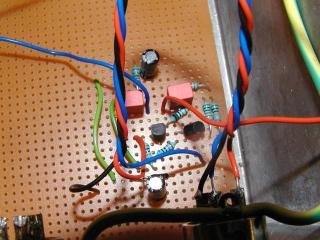
Channel one, component side.
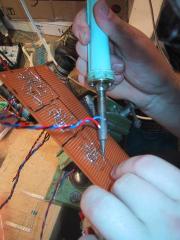
Solder side of 4 channels
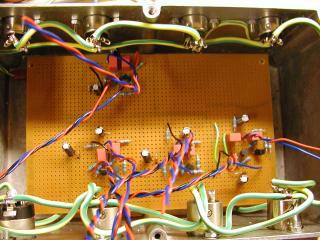
Four channels, mounted in the box.
Finished product
It came out to be two boxes: four channels for the violins, two for
the violas (the cello has an AKG instrument mic in the bridge).
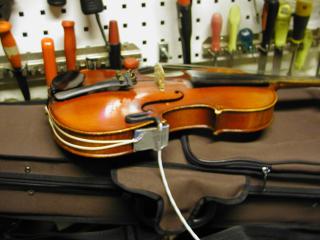
Mounted violin (and our workbench).
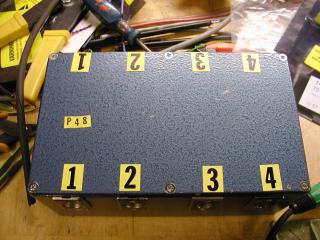
Finished box for the violins. P48; mmm... this runs on 48 volts only. Yummy.
Conclusion
Everything worked on the first try. The circuit works (even after
my soldering this in on veroboard) and so does the microphone. The
isolation is great; with Pink Floyd playing at 100 dB in our workshop
we still only heard the violin. Worked great in the field as well, much like having a portable isobooth. It also sounds much better than a contact mic or having a mic in the bridge. Some EQ:ing required, but it sounds a whole lot better than the alternatives.
Credits
Martin Persson and Martin Björnsson in Linköping for the original
idea, inspiration and drawings. ELFA for the stuff. Radionämnden for
the workshop space, tools, zinc boxes and music (can't work without music). Tomi Engdahl and
Epanorama.net for the circuit design. Most of the physical stuff was done by Måns Nilsson. Circuit
building was done by Ian Delahorne (me).
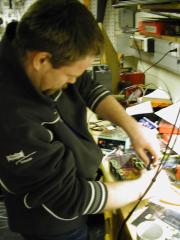
Måns at work on the box
New version
We had a bunch of ideas (well, at least two) for the next
version. We were out of Eurocard-sized veroboard, and veroboard
really sucks anyway. Plus the element was too big.
I spent some time getting to know gEDA and PCB, and ended up with a
reasonable PCB for the project. Drilling PCB's are so much fun, so
next version will probably be SMD. Also, the new element is a lot
smaller. I probably should add new pictures, and recording samples
like I did to the theatre-sound mailing list. Oh, and the PCB worked
on the first try as well
Ian Delahorne, <ian (kanelbulle) stacken.kth.se>
$Id: index.html,v 1.4 2005/08/13 23:34:34 ian Exp $










